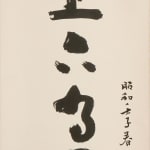Arakawa Toyozo 荒川豊蔵
H34 × W13 in.
H86.3 × W33.0 cm
Mount:
H65 × W16 1/2 in.
H 165.1 × W41.1 cm
Signed and dated 1972 by the artist
Further images
"The bamboo has joints from top to bottom"
The dated inscription next to the above couplet reads: 昭和壬子 (みずのえ ね Shōwa mizunoene) 47年 year (47th year of Showa: 1972). It is signed with Arakawa Toyozo's alternative name: 無田陶人 Muta Tojin*
*Note: Arakawa Toyozo had begun using the two "Literati" or artists names 無田陶人 Muta Tojin and 斗出庵 Tosyutuan after 1972.
This couplet 竹上下有節 carries profound Zen Buddhist connotations related to strength, weakness, and power. It highlights that the strength of bamboo lies in its joints, implying that strength can vary between the upper and lower segments of a single stalk. The couplet is part of a larger Chinese proverb/couplet, which states: 松無古今色、竹有上下節, which translates to "The pine tree's color is timeless; the bamboo has joints from top to bottom."
One interpretation lies with the Japanese historian Haga Koshiro (芳賀幸四郎). In his book, “Shinpan Ichigo-Mono 新版一行物," he writes:
“[...] It is a fallacy to ignore discrimination between men and women, old and young, while insisting only on the aspect of human equality, or, on the other hand, to recognize discrimination between rich and poor, above and below and not recognize equality as a human being, both of which are based on only one aspect of things. It is a truthful and complete view to see equality as discrimination, discrimination as equality, and equality as equality.”
Here, Haga Koshiro describes that this couplet illustrates the concept of equality and discrimination. "No change in color of the pine through the ages" represents the uniformity of equality, while "Bamboo with distinct nodes above and below" highlights the clear distinction of discrimination. Together, they express the universal truth in Zen Buddhism that equality and discrimination are intertwined.
This couplet is a popular phrase practiced in calligraphy, particularly in scroll paintings. With assured strokes, the calligrapher inscribes this simple yet profound declaration of humanity's path in the world. It prompts introspective questions for both the viewer and the artist: "Are we perceiving the true essence with an unbiased heart, or are we being misled by the noisy thoughts of our mind?" This phrase invites one to clear the mind and engage in deep reflection.







